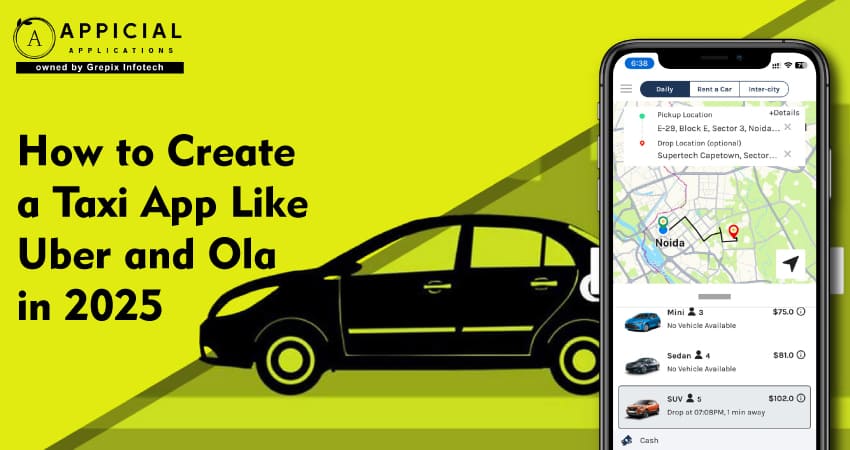
How to Create a Taxi App Like Uber and Ola in 2025
Building a taxi app like Uber and Ola in 2025 is an exciting and rewarding venture that requires meticulous planning, robust technology, and a customer-first approach. Whether you're an entrepreneur or a tech enthusiast, understanding the process is key to success. This guide breaks down the steps and considerations into a comprehensive plan.
The on-demand taxi industry has undergone significant transformation in the past decade. With companies like Uber and Ola setting the benchmark, the industry continues to innovate. As we move into 2025, creating a taxi app involves more than just replicating these giants; it requires understanding evolving trends, embracing cutting-edge technology, and catering to user needs.
Creating a taxi app like Uber or Ola in 2025 involves strategic planning, advanced technology, and user-centric features. The ride-hailing industry is evolving with trends such as electric vehicles (EVs), AI-driven personalization, and autonomous cars. To stand out, focus on safety, sustainability, and seamless experiences. Partnering with a company like Appicial Applications, renowned for its Uber Clone development, can simplify the process by providing customizable, scalable solutions. Essential steps include niche identification, robust tech stacks, MVP development, and strategic marketing. With the right approach, your taxi app can thrive in the competitive market of 2025.
The Current Taxi App Market Overview
Trends in 2025
The taxi app market in 2025 is heavily influenced by advancements in technology. With a focus on sustainability, apps are integrating electric vehicles (EVs) and autonomous driving features. There's also a rising demand for hyper-localized services tailored to specific regions or demographics.
Market Statistics
- The global ride-hailing market is projected to reach $300 billion by 2025.
- Nearly 40% of apps now incorporate AI for route optimization and dynamic pricing.
- Users prioritize apps offering safety features like driver verification and real-time tracking.
Target Audience
Identifying your audience is crucial. Will your app cater to urban commuters, tourists, or businesses needing corporate rides? Defining this can streamline development and marketing efforts.
Regional Focus
Different regions have unique challenges and opportunities. For instance:
- Urban areas require real-time navigation and congestion management.
- Rural areas may need offline functionality and flexible payment options.
Key Features of a Taxi App
Rider-Side Features
- Easy Registration: Social login options for quick onboarding.
- Real-Time Tracking: GPS integration for accurate driver location.
- Payment Integration: Support for multiple payment methods, including digital wallets and cryptocurrencies.
- Safety Features: SOS button, ride-sharing details, and driver ratings.
Driver-Side Features
- Profile Management: Easy document upload and verification.
- Earnings Dashboard: Transparent daily, weekly, and monthly earnings summaries.
- Route Optimization: AI-based navigation for efficient travel.
Admin Panel
- Dashboard Analytics: Insights into app performance and user activity.
- Fleet Management: Real-time tracking of driver availability.
- Complaint Resolution: A portal to handle user and driver concerns.
Technology Stack for Taxi App Development
- Frontend: React Native, Flutter
- Backend: Node.js, Python
- Database: MongoDB, PostgreSQL
- APIs: Google Maps API, Twilio for communication
- Cloud Solutions: Cloud platforms like AWS or Google Cloud ensure your app scales efficiently without service interruptions.
Cloud Solutions
Cloud platforms like AWS or Google Cloud ensure your app scales efficiently without service interruptions.
Building the MVP
What is an MVP?
A Minimum Viable Product (MVP) is a stripped-down version of your app that includes only essential features. It's an excellent way to test your app's viability in the market.
Essential Features
- Rider registration
- Driver registration
- Ride booking and tracking
- Payment gateway
Cost Estimation
Development Cost Factors
Costs depend on app complexity, development team location, and feature set:
- Basic app: $20,000 - $50,000
- Advanced app with AI: $75,000+
- Maintenance Costs: Budget for regular updates, bug fixes, and server costs, typically around 15-20% of development costs annually.
Maintenance Costs
Budget for regular updates, bug fixes, and server costs, typically around 15-20% of development costs annually.
Cost of Developing a Taxi App in 2025
The cost of developing a taxi app like Uber or Ola depends on various factors, including features, platform, location of the development team, and complexity.
Future Perspectives for Taxi Apps
The future of ride-hailing apps is promising, with these trends expected to shape the industry:
- Electric Vehicles (EVs) and Sustainability: With increasing environmental awareness, taxi apps are likely to integrate EV fleets. Governments globally are offering incentives for EV adoption, making this transition economically viable.
- Autonomous Vehicles: By 2025, ride-hailing services may start experimenting with autonomous vehicles for select routes, reducing dependency on drivers and improving efficiency.
- AI-Driven Enhancements: AI will play a crucial role in route optimization for drivers, dynamic pricing based on demand-supply fluctuations, and predictive maintenance of vehicles.
Also Read: Uber Business Model and How Uber Makes Money
Steps to Create a Taxi App
Planning and Research
The foundation of any successful taxi app lies in thorough research. Start by analyzing:
- Competitors like Uber, Ola, and Lyft.
- User pain points such as long waiting times, poor customer service, or limited payment options.
- Emerging trends like EV integration and AI for personalized routes.
- Define your unique value proposition (UVP) that sets your app apart from competitors.
UI/UX Design
User experience is paramount in the taxi industry. Create a clean, intuitive design that guides users effortlessly:
- Wireframes: Sketch the basic layout of your app.
- Mockups: Develop a visual design to show how the app will look and feel.
- Testing: Conduct usability testing with real users to gather feedback and refine the design.
Development
Divide your app into three main modules: rider, driver, and admin. Leverage agile development methodologies for efficient progress:
- Start with the MVP: to test core functionalities.
- Develop APIs: for seamless communication between user modules.
- Focus on scalability: to handle growing user demands.
Testing and Deployment
Extensive testing ensures your app is bug-free and user-friendly:
- Unit Testing: Test individual components.
- Integration Testing: Ensure all modules work cohesively.
- Beta Testing: Release a beta version for a select audience to gather real-world feedback. Deploy the app on platforms like Google Play Store and Apple App Store with proper app store optimization (ASO).
Monetization Strategies
- Commission-Based Model: Take a percentage from every ride booked through your platform. This is the most popular model used by apps like Uber.
- Subscription Plans: Offer premium services such as ad-free experiences, priority bookings, or corporate plans for a monthly or annual fee.
- Advertising: Monetize through in-app advertisements, collaborating with local businesses or brands for targeted campaigns.
- Surge Pricing: Introduce dynamic pricing during peak hours or high demand to boost revenue.
Regulatory and Compliance Requirements
Ensure your app complies with local transportation laws. Obtain necessary permits for operating in specific regions. Protect user data by adhering to regulations like GDPR or CCPA. Implement end-to-end encryption and secure payment gateways. Offer liability insurance for both drivers and passengers to instill trust and ensure compliance with safety regulations.
Marketing Your Taxi App
- Branding: Create a memorable name, logo, and tagline. Consistency in branding builds trust and recognition.
- User Acquisition Strategies: Referral Programs: Reward users for inviting friends to join the app. Social Media Campaigns: Use targeted ads on platforms like Instagram and Facebook. Influencer Marketing: Partner with influencers to promote your app.
- Retention Strategies: Regularly introduce discounts and promotional offers. Provide exceptional customer support with chatbots or live chat options. Gather feedback and implement user suggestions.
Challenges and Solutions
Driver Retention, Competition, and Technical Issues are major challenges. Solutions include offering competitive earnings, focusing on niche markets, and investing in robust cloud infrastructure for app reliability under high traffic.
Emerging Technologies in Taxi Apps
- AI and Machine Learning: AI powers features like demand prediction, dynamic pricing, and fraud detection. Machine learning personalizes user experiences based on ride history and preferences.
- Autonomous Vehicles: Self-driving cars are gradually becoming a reality. Partnering with companies developing autonomous technology can future-proof your app.
- Blockchain Technology: Integrate blockchain for secure payment processing and transparent transactions.
Scaling Your Taxi App
Geographic Expansion
Expand your services to new cities or countries. Adapt the app to local languages, currencies, and regulations.
Adding New Features
Introduce ride-sharing options, EV rentals, or subscription models to attract a wider audience.
Partnership Opportunities
Collaborate with hotels, airports, or corporate offices to grow your customer base.
Conclusion
Creating a taxi app like Uber or Ola in 2025 is a multifaceted process that requires thoughtful planning, advanced technology, and a focus on user experience. By partnering with a reliable development company like Appicial Applications, you can accelerate your journey, ensuring quality and innovation.
As the industry evolves, embracing advancements in AI, electric vehicles, and autonomous driving technology will be crucial. A successful app must not only address current user and driver needs but also anticipate future market trends and regulatory changes. By focusing on robust app development, effective monetization strategies, and dedicated user engagement, entrepreneurs can create a competitive and sustainable service that stands out in the rapidly transforming landscape of urban mobility. Investing in thorough research, data security, and scalable cloud solutions will further solidify the foundation of a dependable and user-centric taxi app.
Stay ahead by embracing emerging technologies, addressing user needs, and continuously innovating to remain competitive in the ever-evolving ride-hailing industry.
Looking out to start your own venture like Uber ? Try out our HireMe Taxi Uber Clone, the easiest way to kick-start your taxi business.
Author's Bio

Vinay Jain is the Founder at Grepix Infotech and brings over 12 years of entrepreneurial experience. His focus revolves around software & business development and customer satisfaction.
Back to blog list






